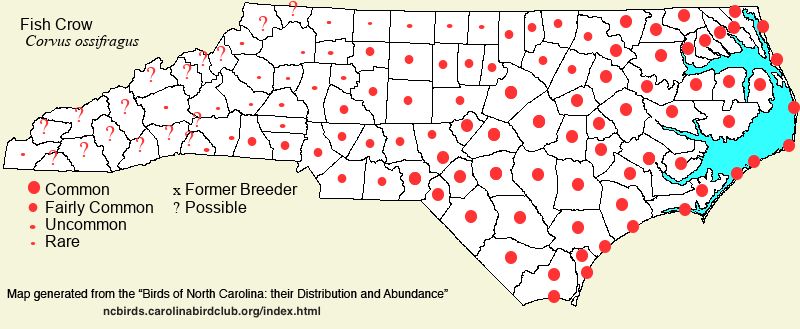 |  |
|
Fish Crow - Corvus ossifragus CORVIDAE Members: | Search Common: Search Scientific: |
|
|
|||||||
| General Comments | Unlike the American Crow, the Fish Crow is poorly known to the layman -- "There are two kinds of crows in the state?". Until the 1960's, this might have been understandable, as this species was known only as a common permanent resident in tidal areas. For whatever reason, numbers started spreading inland into the upper reaches of the Coastal Plain by the mid-1960's, including a few spots along the Piedmont Fall Line. Even now, Fish Crows continue to slowly move farther inland, such that birds now are breeding in all of the Piedmont. It is now being seen sporadically in the mountains, but nesting has not yet been confirmed though birds are undoubtedly doing so. However, the species tends to withdraw back to the Coastal Plain (eastward or southward) for a couple of months in winter. Near the coast, and in many inland areas, they are closely tied to open water -- coastal islands, edges of forests near sounds, and woods adjacent to reservoirs. However, after initial establishment, they often move away from water and feed at landfills and in residential areas, to feed on bird eggs and nestlings, as well as other food off the ground. They avoid feeding in farmland and other cropland, at least in the Piedmont, leaving these areas to the American Crow. Birds nest in evergreen cover of pine stands, broadleaf evergreen forests and thickets, etc. In fall and winter, they typically gather into larger flocks (often over 100 birds) than are the flocks of American Crows; the two species seldom occur in the same flock. | ||||||
| Breeding Status | Breeder | ||||||
| NC BRC List | Definitive | ||||||
| State Status | |||||||
| U.S. Status | |||||||
| State Rank | S5B,S5N | ||||||
| Global Rank | G5 | ||||||
| Coastal Plain | Permanent resident over most of the area, with migratory movements. Generally, common to locally very common along the coast and in Tidewater, and now common inland. Can be locally uncommon in some inland areas in winter, especially in the northwestern portions. Because it gathers into large flocks in winter, it can be locally scarce for various periods, even in some coastal areas. Peak counts: 10,000 at a roost north of Engelhard (Hyde), 14-16 Feb 1987; 3,000, roost near Warsaw (Duplin), 23 Dec 2021. | ||||||
| Piedmont | Summer resident, remaining into late fall, and sparingly winters in the eastern portions; still slowly increasing. In the warmer months, common in the eastern and southern portions, but uncommon and local toward the foothills. Unpredictable in winter, depending on the severity of the weather. Peak counts: 207, Ringwood (Halifax), 13 Oct 1986. | ||||||
| Mountains | Greatly increasing visitor and presumed local breeder; a recent arrival, since 2006. Now surely nesting at a few places, but no active nest has been found; an adult was seen carrying food in Cherokee in 2025. In recent years (2019-25) there are quite a few records for the northern mountains, mostly from Watauga. A count of 9, possibly including juveniles, was noted in Boone (Watauga) on 15 Jul 2021; no conclusive breeding evidence exists for this province, though it would be little surprise if such evidence were found in the next few years. In fact, in spring 2024 and spring 2025, the species was reported on eBird lists from all 17 counties in the province. In summer 2024, adults carrying food were seen in Buncombe. A few birds are now (2024) overwintering as far north as Watauga. Peak counts: 9, see above; 8, Henderson, 12 May 2009. | ||||||
| Finding Tips |
Easy to find, and not local, in the breeding season, in most of the Coastal Plain, especially around salt or brackish water. Typically easy to find in the warmer months in many Piedmont cities and large towns. **** | ||||||
| Attribution | LeGrand[2025-10-22], LeGrand[2025-07-28], LeGrand[2024-11-06] | ||||||
| NC Map Map depicts all counties with a report (transient or resident) for the species. | Click on county for list of all known species. |
| NC Breeding Season Map Map depicts assumed breeding season abundance for the species. |  |